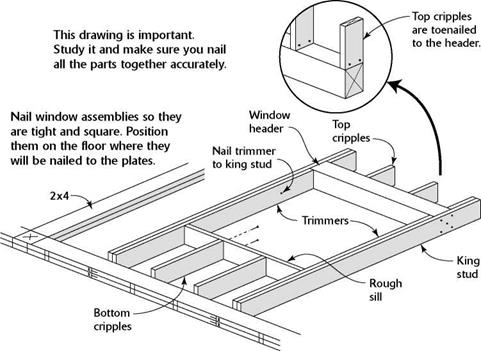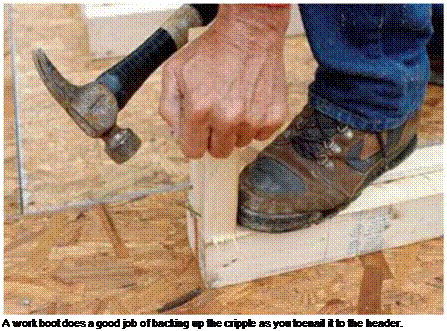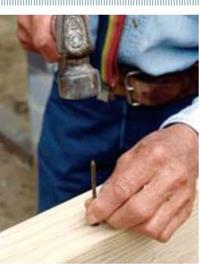NAILING TOGETHER THE WINDOW FRAME ASSEMBLIES
|


When you come to a door or window opening, just continue the stud layout, marking cripple locations on the headers and the rough sills. Lay out all exterior walls and then begin on the interior walls. The layout of interior walls is not as critical as that of exterior walls, because most drywall hangers use long sheets of drywall, which often run from corner to corner. Just put the stick in a corner against a through wall and start marking. Make sure you put the stud markings on the same side of the plates as the header markings. When you encounter rough plumbing, don’t put a stud next to a pipe. Give the plumbers room to finish their work. Each intersecting wall automatically has a stud on each end, so there’s no need to mark those locations.
Old codes required that a stud be placed under every break in the top plate. Here in the West, this hasn’t been a requirement for nearly 40 years, but check with your local building inspector. My guess is that few, if any, areas in the country still require it. As long as you have
a double top plate, locating a stud under a plate break adds little to the structural integrity of the frame.
Because of the sheer number of marks required on walls, it’s a good idea to walk through every “room” after you have finished marking all the plates. Visually check whether all of the wall plates, headers, rough sills, corners, and channels are properly marked. The time you take to inspect your work now can save you much more time later. It takes a lot longer to tear out studs and frame a door that was missed during layout than it does to take a leisurely but focused stroll through the house to make sure everything is in order.
In addition to being a carpenter for the past 50 years, I’ve also been a gardener my entire life, and I see a lot of similarities between framing and gardening. If you take the time to prepare

![NAILING TOGETHER THE WINDOW FRAME ASSEMBLIES Подпись: Door and window assemblies are nailed together and ready to be installed between the top and bottom wall plates. [Photo © Larry Haun]](/img/1312/image312.gif) the ground, add lots of compost, plant good seeds, mulch well, and nurture young plants, you can’t help but grow outstanding vegetables. The situation is similar when you’re framing walls. If you take the time to lay out, cut, and correctly position every part of every wall, then the actual framing will go smoothly and you’ll produce a quality building.
the ground, add lots of compost, plant good seeds, mulch well, and nurture young plants, you can’t help but grow outstanding vegetables. The situation is similar when you’re framing walls. If you take the time to lay out, cut, and correctly position every part of every wall, then the actual framing will go smoothly and you’ll produce a quality building.
A Habitat volunteer once said to me, “Now the fun starts,” as we began to nail together all the wall pieces. I guess everything in life is relative. If you have to stand out in the blazing sun building walls day in and day out, the joy of framing does eventually wear off. On the other hand, when working as a team, a group of people building walls will see a lot of progress in one day, and that is satisfying.
Before I start building walls, I always begin by cleaning up the work area. Some scrap will have been generated as you cut the parts for the walls and there’s no need to leave it lying around for someone to trip over.







Leave a reply